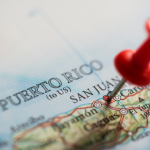In Summary
- Plan Qualification and Tax Treatment: Retirement plans established in Puerto Rico (PR) receive favorable U.S. tax treatment under ERISA Section 1022(i). Plans covering only PR residents (1022(i)(1)) are exempt from U.S. taxation on trust income, while plans electing full U.S. compliance (1022(i)(2)) can cover both U.S. and PR employees.
- Key Regulatory Differences Must Be Met: Plans covering Puerto Rican employees must secure a qualification letter from the PR Hacienda, even if U.S.-qualified. The Puerto Rico Code differs from the Internal Revenue Code regarding coverage testing, the definition of Highly Compensated Employee, ADP testing, and contribution limits.
- Required Filing for Plans: All ERISA-covered plans, including dual-qualified plans, must file the Form 5500-series return, using specific characteristic codes for PR involvement. Additionally, all plans with PR participants are required to file Form 480.70 with the local Hacienda.
_______________________________________________________________________
 Background Information
Background Information
Puerto Rico is a territory of the United States along with American Samoa, Guam, the Northern Mariana Islands, and the U.S. Virgin Islands.
The Commonwealth of Puerto Rico falls under the jurisdiction of most federal laws of the United States. However, significant taxation differences exist. Puerto Rico has its own constitution and a system of government very similar to that of most states in the Union, but Puerto Rican Residents pay taxes to the Puerto Rican Treasury, called Hacienda, and they do not pay income tax to the United States on income earned in Puerto Rico. Since Puerto Ricans are US citizens, Social Security taxes do apply to residents of Puerto Rico, even if income taxes do not.
Retirement Plan Qualification
Under ERISA Section 1022(i), sponsors of pension, profit-sharing, or stock bonus plans created or organized in Puerto Rico with Puerto Rico trusts, are eligible for two types of favorable tax treatment under the Internal Revenue Code:
- Under ERISA Section 1022(i)(1), if the Puerto Rico plan is exempt under Puerto Rico Code Section 1165 and all of the participants are residents of Puerto Rico, the trust will be treated as exempt under Internal Revenue Code Section 501(a) as if it were part of a qualified plan under Internal Revenue Code Section 401(a). The effect of ERISA Section 1022(i)(1) is to exclude trust income earned in the U.S. from U.S. taxation.
- ERISA Section 1022(i)(2) provides that a sponsor of a Puerto Rican plan can make an irrevocable election for the plan to comply with all of the Internal Revenue Code’s qualification provisions except for the trust situs requirement. An election to maintain an ERISA Section 1022(i)(2) plan enables the plan to cover both U.S. and Puerto Rican employees.
“Dual-qualified” plans have U.S. domestic trusts that cover Puerto Rican employees and qualify under both the Puerto Rico Code and the Internal Revenue Code to provide the Puerto Rican participants with favorable tax benefits.
A retirement plan and any amendments made to the plan that covers Puerto Rican employees must apply for and receive a letter from the Puerto Rico Hacienda before the plan is qualified under the Puerto Rico Code.
The provisions of the Puerto Rico Code (in Spanish) apply to all qualified retirement plans that cover employees working on the Island, even those plans that are also qualified in the United States. Hacienda’s Circular Letter No. 11-10 (as modified by Circular Letter No. 13-02) describes the statutory changes that must be included in a plan document under the Puerto Rico Code. Plan sponsors of either Puerto Rico-only or dual-qualified plans must adopt these amendments to comply with the Puerto Rico Code by the due date, including any extension, of the employer’s Puerto Rico income tax return for the 2013 taxable year.
The Internal Revenue Code and Puerto Rico Code have different requirements for cash or deferred arrangement plans. The major differences are:
- the method for determining excluded employees under coverage testing;
- the definition of Highly Compensated Employee;
- average Deferral Percentage test, methodology and correction methods;
- the dollar amount that can be deferred; and
- a lower catch-up contribution limit for participants 50 years of age or older.
Please refer to our 2024 Plan Limits for Puerto Rico blog for specific limit amounts. The specifics of coverage testing, the Puerto Rico ADP test and correction methods are beyond the scope of this article.
Reporting Requirements
All pension plans covered by ERISA, including dual-qualified plans, are required to file a Form 5500-series return. Plans that are qualified in Puerto Rico and not in the U.S. should include on line 8 the plan characteristic code 3C – Plan not intended to be qualified under Internal Revenue Code Sections 401, 403 or 408. Enter 3J for U.S.-based plans that cover Puerto Rican residents and are qualified under both the Internal Revenue and Puerto Rico Codes.
All plans that have participants in Puerto Rico must file Form 480.70 with Hacienda.
Since ERISA Section 1022(i)(2) plans and dual-qualified plans are exempt from income taxes, but not exempt from excise taxes, Form 5330 must be filed, when penalties are applicable.
Audit Requirements
The Independent Qualified Public Accountant audit rules apply to each filed Form 5500 individually. Please see our blogs titled Learning How to Count Again and Counting What Counts, Counts the Auditors Out! for additional details.
ERISA-covered Puerto Rico plans that file a Form 5500 are subject to the same 5500 audit rules as US plans.
